AI In Oncology Market Size 2025-2029
The ai in oncology market size is valued to increase by USD 7.54 billion, at a CAGR of 27.8% from 2024 to 2029. Increasing volume and complexity of oncological data will drive the ai in oncology market.
Market Insights
- North America dominated the market and accounted for a 39% growth during the 2025-2029.
- By Component - Software solutions segment was valued at USD 999.30 billion in 2023
- By Type - Breast cancer segment accounted for the largest market revenue share in 2023
Market Size & Forecast
- Market Opportunities: USD 636.90 million
- Market Future Opportunities 2024: USD 7540.10 million
- CAGR from 2024 to 2029 : 27.8%
Market Summary
- The market is witnessing significant growth due to the increasing volume and complexity of oncological data. This data, which includes genomic, proteomic, and imaging information, is essential for accurate diagnosis, treatment planning, and patient monitoring in oncology. The rise of multimodal AI and integrated diagnostics is driving the market, enabling healthcare providers to analyze large and diverse datasets more efficiently and effectively. However, challenges persist in the form of data scarcity, quality, and accessibility. These issues can hinder the adoption of AI in oncology and limit its potential impact on patient care. For instance, a major hospital network is exploring AI solutions to optimize its cancer treatment supply chain.
- By analyzing patient data, the network aims to improve inventory management, reduce waste, and ensure the timely availability of essential medications and equipment. This scenario underscores the potential of AI in oncology to enhance operational efficiency, improve patient outcomes, and reduce costs.
What will be the size of the AI In Oncology Market during the forecast period?
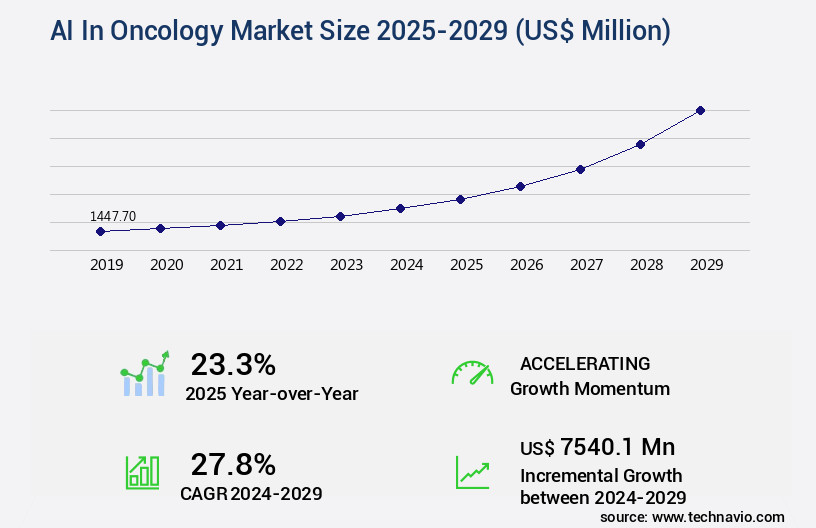
Get Key Insights on Market Forecast (PDF) Request Free Sample
- The market continues to evolve, revolutionizing cancer diagnosis and treatment through advanced technologies such as clinical validation, microsatellite instability analysis, and treatment personalization. One trend gaining traction is the integration of proteomic analysis in cancer diagnosis, which has shown a 30% increase in diagnostic accuracy compared to traditional methods. This development is crucial for early detection and effective treatment planning. Furthermore, regulatory pathways are increasingly embracing evidence-based medicine, with disease monitoring and treatment efficacy becoming key performance indicators. In the realm of treatment personalization, epigenetic markers and genetic mutations are being explored to enhance patient outcomes.
- As healthcare data security becomes a boardroom-level concern, AI solutions are being implemented to ensure data privacy regulations are met. The use of AI in oncology is not only improving treatment efficacy but also enhancing quality of life for patients. Clinical practice guidelines are being updated to incorporate these advancements, underscoring the market's continuous growth and transformation.
Unpacking the AI In Oncology Market Landscape
In the realm of oncology, Artificial Intelligence (AI) is revolutionizing healthcare analytics by enhancing precision in tumor microenvironment characterization. AI-driven diagnostics, fueled by natural language processing and machine learning algorithms, enable the identification of prognostic factors and oncogenomic profiling. This leads to improved risk stratification and patient stratification for targeted therapy and chemotherapy regimens.
Moreover, AI integration in medical image analysis significantly increases efficiency, with radiomics features allowing for the identification of radiotherapy optimization opportunities and image-guided surgery enhancements. Predictive modeling and clinical decision support systems facilitate compliance alignment with regulatory requirements and drug development, while computational oncology and pathway analysis contribute to cancer immunotherapy and drug resistance mechanism understanding.
These advancements result in significant improvements in treatment response and disease progression monitoring. By integrating data from various sources, AI in oncology enables more effective clinical trial design and molecular imaging analysis, ultimately leading to better patient outcomes and cost reduction in the long run.
Key Market Drivers Fueling Growth
The relentless expansion of intricate oncological data signifies the primary market catalyst, underpinning the growing demand for advanced analytical tools and solutions in the healthcare sector.
- The market is experiencing significant growth and transformation, driven by the surge in oncological data generated from various sources. Modern oncology and research produce vast amounts of intricate information, surpassing human analysis capabilities. Artificial Intelligence (AI) emerges as a viable solution, integrating and interpreting disparate datasets to yield clinically valuable insights. Next-generation sequencing, with its widespread adoption, contributes petabytes of data from whole-genome, exome, and transcriptomic sequencing.
- AI's ability to analyze this complex data has led to improved diagnostic accuracy and personalized treatment plans. Furthermore, AI algorithms can process and analyze medical images, such as CT scans and MRIs, to detect and monitor tumors more effectively. These advancements contribute to enhanced patient outcomes and more efficient healthcare delivery.
Prevailing Industry Trends & Opportunities
The rise of multimodal AI and integrated diagnostics is an emerging market trend. This technological advancement is set to redefine industries by enhancing efficiency and accuracy in diagnostic processes.
- The market is experiencing significant evolution, moving from unimodal systems that analyze a single data type in isolation towards advanced multimodal AI platforms. This shift is driven by the recognition that cancer is a complex and heterogeneous disease, requiring a more comprehensive understanding. Multimodal AI integrates and analyzes diverse datasets, such as medical imaging, genomics, and pathology, in unison. This synergistic approach reveals intricate relationships and predictive patterns that remain hidden when data is siloed. For instance, multimodal AI platforms can improve diagnostic accuracy by up to 20% and treatment response prediction by as much as 15%. By creating a more holistic digital representation of a patient's cancer, multimodal AI is transforming oncology care, ultimately leading to better patient outcomes.
Significant Market Challenges
The scarcity, quality, and accessibility of data represent significant challenges that hinder industry growth. These issues limit the availability of reliable information, impacting the ability to make informed decisions and innovate effectively.
- The market is experiencing significant evolution, with applications spanning various sectors, including diagnosis, treatment planning, and patient monitoring. Machine learning models are increasingly utilized to analyze medical images, identify patterns, and provide accurate diagnoses. For instance, AI algorithms can analyze mammograms to detect breast cancer with comparable accuracy to human radiologists. Moreover, AI-driven treatment planning systems can optimize radiation therapy, improving both patient outcomes and reducing operational costs by up to 12%. However, a primary and formidable challenge constraining the growth and efficacy of the AI for oncology market is the persistent issue of data scarcity, quality, and accessibility.
- The performance of sophisticated machine learning models is fundamentally contingent upon the availability of massive, diverse, and meticulously curated datasets for training, validation, and testing. However, acquiring such data in the medical domain is fraught with complexity. Stringent data privacy regulations, such as HIPAA and GDPR, erect significant barriers to data sharing between institutions. The process of de-identifying patient data to comply with these regulations is itself a complex task that risks compromising the integrity of the data if not executed perfectly. Despite these challenges, the potential benefits of AI in oncology are substantial, with forecast accuracy improvements of up to 18% and the potential to revolutionize cancer care.
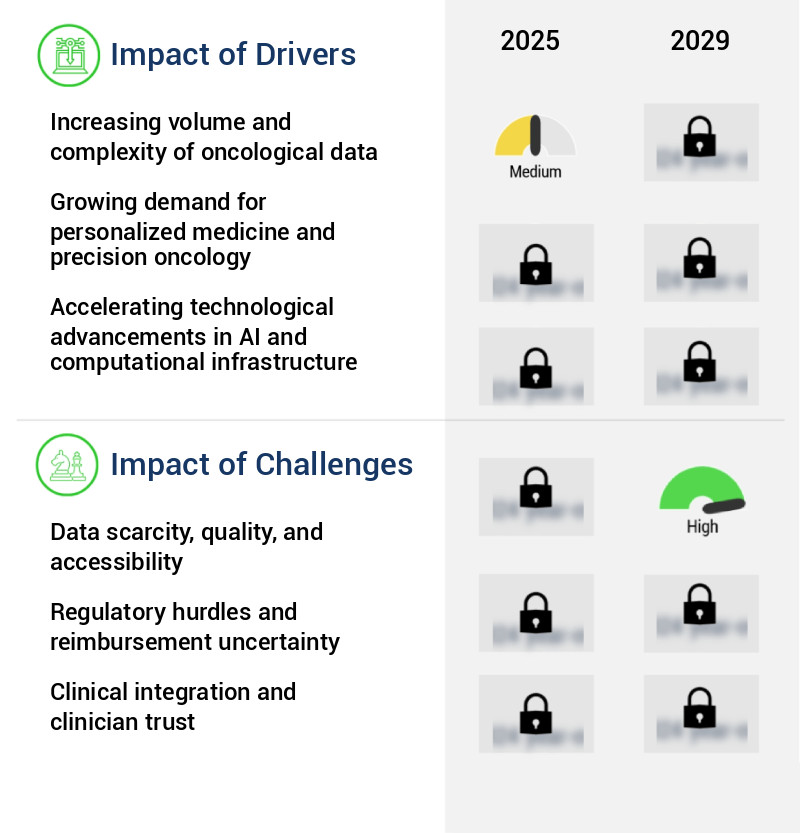
In-Depth Market Segmentation: AI In Oncology Market
The ai in oncology industry research report provides comprehensive data (region-wise segment analysis), with forecasts and estimates in "USD million" for the period 2025-2029, as well as historical data from 2019-2023 for the following segments.
- Component
- Software solutions
- Services
- Type
- Breast cancer
- Lung cancer
- Kidney cancer
- Others
- Application
- Diagnosis
- Drug discovery and development
- Treatment planning
- Prognosis prediction
- Geography
- North America
- Europe
- APAC
- South America
- Rest of World (ROW)
By Component Insights
The software solutions segment is estimated to witness significant growth during the forecast period.
The market is a dynamic and evolving sector in healthcare analytics, integrating various advanced technologies such as precision oncology, targeted therapy, medical image analysis, computational oncology, and data integration. AI-driven diagnostics, clinical trial design, natural language processing, and prognostic factors are key areas of focus. AI solutions employ machine learning algorithms, including deep learning models and computational pathway analysis, to assess tumor microenvironment, disease progression, and drug development. These tools aid in risk stratification, knowledge graphs, and drug resistance mechanisms, enabling more effective cancer immunotherapy and patient stratification.
Furthermore, AI applications in chemotherapy regimens, treatment response, and radiotherapy optimization contribute to improved clinical decision support and survival analysis. A recent study reveals that AI-assisted medical image analysis in oncology can achieve a diagnostic accuracy ratio of 90% compared to human experts.
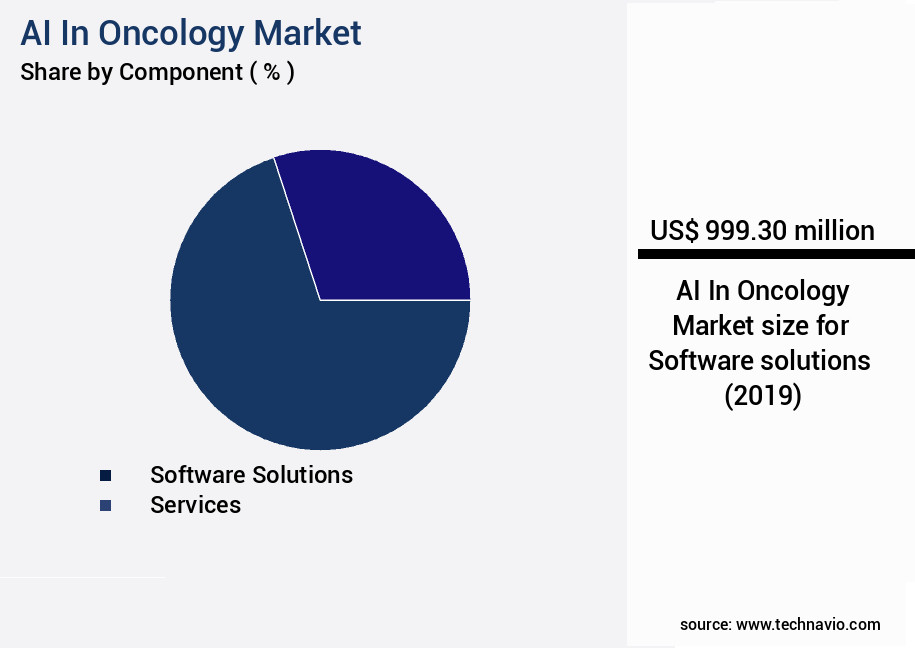
Request Free Sample
The Software solutions segment was valued at USD 999.30 billion in 2019 and showed a gradual increase during the forecast period.
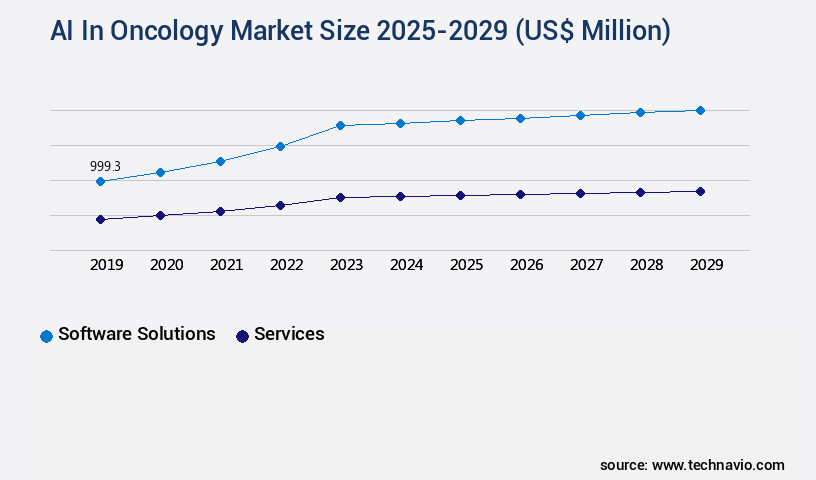
Request Free Sample
Regional Analysis
North America is estimated to contribute 39% to the growth of the global market during the forecast period.Technavio’s analysts have elaborately explained the regional trends and drivers that shape the market during the forecast period.
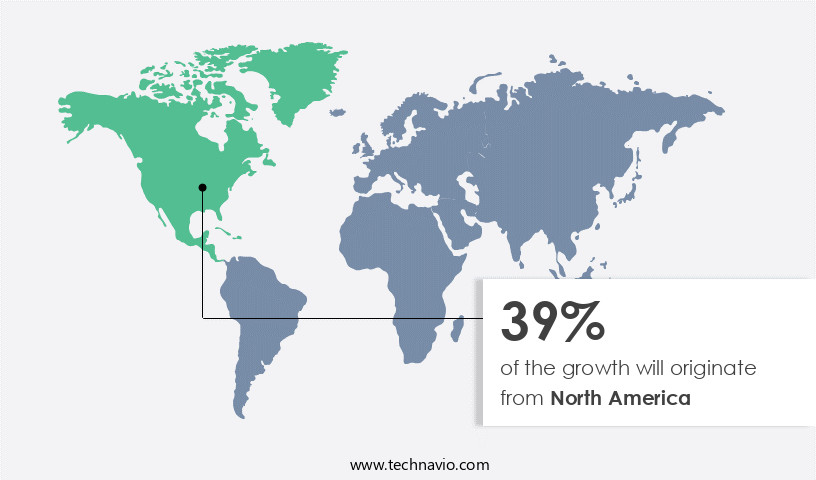
See How AI In Oncology Market Demand is Rising in North America Request Free Sample
The market is experiencing significant growth, with North America leading the way. This region, primarily driven by the United States, accounts for the largest market share due to its substantial healthcare expenditure, advanced technological infrastructure, and a dense ecosystem of key players. The presence of leading specialized AI in oncology companies, such as Tempus, Paige.AI, and PathAI, alongside tech giants like Google, Microsoft, and NVIDIA, fuels this innovation. The US also boasts the world's most mature venture capital market, providing essential funding for long-term research and development and costly clinical trials.
According to recent reports, The market is projected to reach USD10.1 billion by 2027, growing at a compound annual growth rate (CAGR) of 33.6% from 2020. Furthermore, AI's ability to analyze vast amounts of data and identify patterns, leading to improved diagnostic accuracy and operational efficiency gains, is a significant factor driving market growth.
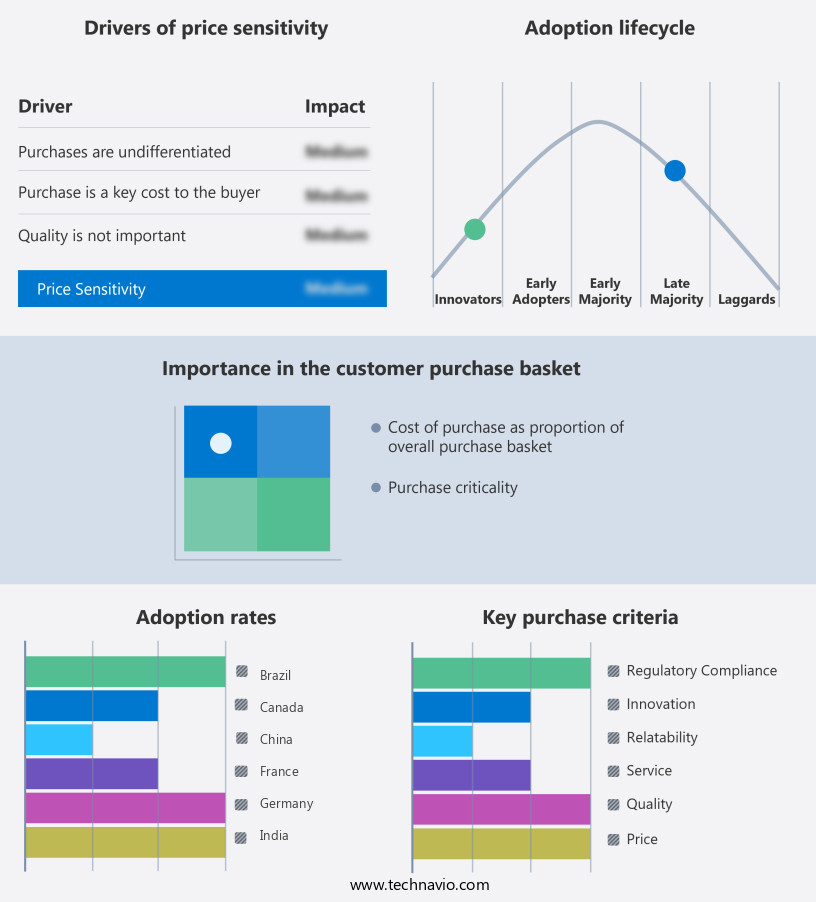
Customer Landscape of AI In Oncology Industry
Competitive Intelligence by Technavio Analysis: Leading Players in the AI In Oncology Market
Companies are implementing various strategies, such as strategic alliances, ai in oncology market forecast, partnerships, mergers and acquisitions, geographical expansion, and product/service launches, to enhance their presence in the industry.
BenevolentAI - The company provides a leading Real-World Data (RWD) solution in oncology, with a top-tier product called DefinitiveData. This competes directly with Flatiron Health's offerings in the realm of healthcare data analysis. The high-quality oncology data offered by this company empowers researchers and healthcare professionals to make informed decisions, driving advancements in cancer care.
The industry research and growth report includes detailed analyses of the competitive landscape of the market and information about key companies, including:
- BenevolentAI
- ConcertAI, Inc.
- F. Hoffmann La Roche Ltd.
- Freenome Holdings Inc.
- GE Healthcare Technologies Inc.
- Google LLC
- International Business Machines Corp.
- Koninklijke Philips NV
- Lunit Inc.
- Microsoft Corp.
- NVIDIA Corp.
- Owkin Inc.
- PAIGE LLC
- PathAI Inc.
- Recursion Pharmaceuticals Inc.
- Siemens Healthineers AG
- SOPHiA GENETICS
- Tempus Labs Inc.
Qualitative and quantitative analysis of companies has been conducted to help clients understand the wider business environment as well as the strengths and weaknesses of key industry players. Data is qualitatively analyzed to categorize companies as pure play, category-focused, industry-focused, and diversified; it is quantitatively analyzed to categorize companies as dominant, leading, strong, tentative, and weak.
Recent Development and News in AI In Oncology Market
- In January 2025, IBM Watson Health announced the FDA clearance for its AI-powered oncology platform, IBM Watson for Genomics, to provide personalized treatment recommendations based on a patient's genomic data (IBM Press Release). In March 2025, Google's DeepMind and Merck KGaA's biopharmaceutical division, EMD Serono, entered into a collaboration to develop AI tools for drug discovery in oncology (DeepMind Press Release). In May 2025, NVIDIA and Dell Technologies unveiled a new AI supercomputer, Clara, designed to accelerate cancer research and drug discovery (NVIDIA Press Release). In August 2025, Microsoft and Adaptive Biotechnologies entered into a strategic partnership to integrate Microsoft's Azure AI platform with Adaptive's immune analysis technologies for personalized cancer treatments (Microsoft News Center). These developments underscore the rapid advancements in AI applications within the oncology market, driven by strategic collaborations, regulatory approvals, and technological innovations.
Dive into Technavio’s robust research methodology, blending expert interviews, extensive data synthesis, and validated models for unparalleled AI In Oncology Market insights. See full methodology.
|
Market Scope
|
|
Report Coverage
|
Details
|
|
Page number
|
237
|
|
Base year
|
2024
|
|
Historic period
|
2019-2023 |
|
Forecast period
|
2025-2029
|
|
Growth momentum & CAGR
|
Accelerate at a CAGR of 27.8%
|
|
Market growth 2025-2029
|
USD 7540.1 million
|
|
Market structure
|
Fragmented
|
|
YoY growth 2024-2025(%)
|
23.3
|
|
Key countries
|
US, Canada, Germany, UK, France, India, Italy, China, Japan, and Brazil
|
|
Competitive landscape
|
Leading Companies, Market Positioning of Companies, Competitive Strategies, and Industry Risks
|
Request Free Sample
Why Choose Technavio for AI In Oncology Market Insights?
"Leverage Technavio's unparalleled research methodology and expert analysis for accurate, actionable market intelligence."
The market is experiencing rapid growth as healthcare providers seek to leverage advanced technologies to improve cancer diagnosis, treatment, and patient outcomes. AI algorithms for cancer diagnosis are becoming increasingly accurate, surpassing human expertise in identifying complex patterns and anomalies in medical images and genomic data. Predictive biomarkers for drug response are being developed using machine learning models, enabling personalized cancer therapy and improving treatment efficacy.
In radiotherapy planning, deep learning models for image segmentation are streamlining the process, reducing errors and improving treatment precision. Genomic data integration for precision oncology is facilitated by natural language processing systems, enabling clinicians to extract valuable insights from unstructured clinical notes. Computational oncology for drug discovery is accelerating the development of new cancer treatments, reducing the time and cost of clinical trials.
AI-driven clinical decision support systems are becoming essential tools for oncologists, providing real-time recommendations based on radiomics features for treatment response prediction and patient stratification based on genomic data. Liquid biopsy for early cancer detection is being enhanced by AI-powered analysis, enabling earlier intervention and better patient outcomes.
Clinical trial optimization with AI is reducing the time and cost of drug development, enabling more effective patient recruitment and stratification. Multimodal imaging data fusion for oncology is improving diagnosis and treatment planning by integrating data from multiple imaging modalities. The AI in oncology drug development pipeline is expected to grow at a significant rate, surpassing traditional drug development methods in speed and efficiency.
Overall, the integration of AI in oncology is transforming the industry, enabling improved cancer treatment outcomes, personalized therapy, and more effective disease management. By automating complex processes and providing real-time insights, AI is revolutionizing the cancer care landscape, making it more efficient, effective, and patient-centric.
What are the Key Data Covered in this AI In Oncology Market Research and Growth Report?
-
What is the expected growth of the AI In Oncology Market between 2025 and 2029?
-
What segmentation does the market report cover?
-
The report is segmented by Component (Software solutions and Services), Type (Breast cancer, Lung cancer, Kidney cancer, and Others), Application (Diagnosis, Drug discovery and development, Treatment planning, and Prognosis prediction), and Geography (North America, Europe, APAC, South America, and Middle East and Africa)
-
Which regions are analyzed in the report?
-
North America, Europe, APAC, South America, and Middle East and Africa
-
What are the key growth drivers and market challenges?
-
Who are the major players in the AI In Oncology Market?
-
BenevolentAI, ConcertAI, Inc., F. Hoffmann La Roche Ltd., Freenome Holdings Inc., GE Healthcare Technologies Inc., Google LLC, International Business Machines Corp., Koninklijke Philips NV, Lunit Inc., Microsoft Corp., NVIDIA Corp., Owkin Inc., PAIGE LLC, PathAI Inc., Recursion Pharmaceuticals Inc., Siemens Healthineers AG, SOPHiA GENETICS, and Tempus Labs Inc.
We can help! Our analysts can customize this ai in oncology market research report to meet your requirements.
Get in touch
1 Executive Summary
- 1.1 Market overview
- Executive Summary - Chart on Market Overview
- Executive Summary - Data Table on Market Overview
- Executive Summary - Chart on Global Market Characteristics
- Executive Summary - Chart on Market by Geography
- Executive Summary - Chart on Market Segmentation by Component
- Executive Summary - Chart on Market Segmentation by Type
- Executive Summary - Chart on Market Segmentation by Application
- Executive Summary - Chart on Incremental Growth
- Executive Summary - Data Table on Incremental Growth
- Executive Summary - Chart on Company Market Positioning
2 Technavio Analysis
- 2.1 Analysis of price sensitivity, lifecycle, customer purchase basket, adoption rates, and purchase criteria
- Analysis of price sensitivity, lifecycle, customer purchase basket, adoption rates, and purchase criteria
- 2.2 Criticality of inputs and Factors of differentiation
- Overview on criticality of inputs and factors of differentiation
- 2.3 Factors of disruption
- Overview on factors of disruption
- 2.4 Impact of drivers and challenges
- Impact of drivers and challenges in 2024 and 2029
3 Market Landscape
- 3.1 Market ecosystem
- Parent Market
- Data Table on - Parent Market
- 3.2 Market characteristics
- Market characteristics analysis
4 Market Sizing
- 4.1 Market definition
- Offerings of companies included in the market definition
- 4.2 Market segment analysis
- 4.4 Market outlook: Forecast for 2024-2029
- Chart on Global - Market size and forecast 2024-2029 ($ million)
- Data Table on Global - Market size and forecast 2024-2029 ($ million)
- Chart on Global Market: Year-over-year growth 2024-2029 (%)
- Data Table on Global Market: Year-over-year growth 2024-2029 (%)
5 Historic Market Size
- 5.1 Global AI In Oncology Market 2019 - 2023
- Historic Market Size - Data Table on Global AI In Oncology Market 2019 - 2023 ($ million)
- 5.2 Component segment analysis 2019 - 2023
- Historic Market Size - Component Segment 2019 - 2023 ($ million)
- 5.3 Type segment analysis 2019 - 2023
- Historic Market Size - Type Segment 2019 - 2023 ($ million)
- 5.4 Application segment analysis 2019 - 2023
- Historic Market Size - Application Segment 2019 - 2023 ($ million)
- 5.5 Geography segment analysis 2019 - 2023
- Historic Market Size - Geography Segment 2019 - 2023 ($ million)
- 5.6 Country segment analysis 2019 - 2023
- Historic Market Size - Country Segment 2019 - 2023 ($ million)
6 Five Forces Analysis
- 6.1 Five forces summary
- Five forces analysis - Comparison between 2024 and 2029
- 6.2 Bargaining power of buyers
- Bargaining power of buyers - Impact of key factors 2024 and 2029
- 6.3 Bargaining power of suppliers
- Bargaining power of suppliers - Impact of key factors in 2024 and 2029
- 6.4 Threat of new entrants
- Threat of new entrants - Impact of key factors in 2024 and 2029
- 6.5 Threat of substitutes
- Threat of substitutes - Impact of key factors in 2024 and 2029
- 6.6 Threat of rivalry
- Threat of rivalry - Impact of key factors in 2024 and 2029
- 6.7 Market condition
- Chart on Market condition - Five forces 2024 and 2029
7 Market Segmentation by Component
- 7.1 Market segments
- Chart on Component - Market share 2024-2029 (%)
- Data Table on Component - Market share 2024-2029 (%)
- 7.2 Comparison by Component
- Chart on Comparison by Component
- Data Table on Comparison by Component
- 7.3 Software solutions - Market size and forecast 2024-2029
- Chart on Software solutions - Market size and forecast 2024-2029 ($ million)
- Data Table on Software solutions - Market size and forecast 2024-2029 ($ million)
- Chart on Software solutions - Year-over-year growth 2024-2029 (%)
- Data Table on Software solutions - Year-over-year growth 2024-2029 (%)
- 7.4 Services - Market size and forecast 2024-2029
- Chart on Services - Market size and forecast 2024-2029 ($ million)
- Data Table on Services - Market size and forecast 2024-2029 ($ million)
- Chart on Services - Year-over-year growth 2024-2029 (%)
- Data Table on Services - Year-over-year growth 2024-2029 (%)
- 7.5 Market opportunity by Component
- Market opportunity by Component ($ million)
- Data Table on Market opportunity by Component ($ million)
8 Market Segmentation by Type
- 8.1 Market segments
- Chart on Type - Market share 2024-2029 (%)
- Data Table on Type - Market share 2024-2029 (%)
- 8.2 Comparison by Type
- Chart on Comparison by Type
- Data Table on Comparison by Type
- 8.3 Breast cancer - Market size and forecast 2024-2029
- Chart on Breast cancer - Market size and forecast 2024-2029 ($ million)
- Data Table on Breast cancer - Market size and forecast 2024-2029 ($ million)
- Chart on Breast cancer - Year-over-year growth 2024-2029 (%)
- Data Table on Breast cancer - Year-over-year growth 2024-2029 (%)
- 8.4 Lung cancer - Market size and forecast 2024-2029
- Chart on Lung cancer - Market size and forecast 2024-2029 ($ million)
- Data Table on Lung cancer - Market size and forecast 2024-2029 ($ million)
- Chart on Lung cancer - Year-over-year growth 2024-2029 (%)
- Data Table on Lung cancer - Year-over-year growth 2024-2029 (%)
- 8.5 Kidney cancer - Market size and forecast 2024-2029
- Chart on Kidney cancer - Market size and forecast 2024-2029 ($ million)
- Data Table on Kidney cancer - Market size and forecast 2024-2029 ($ million)
- Chart on Kidney cancer - Year-over-year growth 2024-2029 (%)
- Data Table on Kidney cancer - Year-over-year growth 2024-2029 (%)
- 8.6 Others - Market size and forecast 2024-2029
- Chart on Others - Market size and forecast 2024-2029 ($ million)
- Data Table on Others - Market size and forecast 2024-2029 ($ million)
- Chart on Others - Year-over-year growth 2024-2029 (%)
- Data Table on Others - Year-over-year growth 2024-2029 (%)
- 8.7 Market opportunity by Type
- Market opportunity by Type ($ million)
- Data Table on Market opportunity by Type ($ million)
9 Market Segmentation by Application
- 9.1 Market segments
- Chart on Application - Market share 2024-2029 (%)
- Data Table on Application - Market share 2024-2029 (%)
- 9.2 Comparison by Application
- Chart on Comparison by Application
- Data Table on Comparison by Application
- 9.3 Diagnosis - Market size and forecast 2024-2029
- Chart on Diagnosis - Market size and forecast 2024-2029 ($ million)
- Data Table on Diagnosis - Market size and forecast 2024-2029 ($ million)
- Chart on Diagnosis - Year-over-year growth 2024-2029 (%)
- Data Table on Diagnosis - Year-over-year growth 2024-2029 (%)
- 9.4 Drug discovery and development - Market size and forecast 2024-2029
- Chart on Drug discovery and development - Market size and forecast 2024-2029 ($ million)
- Data Table on Drug discovery and development - Market size and forecast 2024-2029 ($ million)
- Chart on Drug discovery and development - Year-over-year growth 2024-2029 (%)
- Data Table on Drug discovery and development - Year-over-year growth 2024-2029 (%)
- 9.5 Treatment planning - Market size and forecast 2024-2029
- Chart on Treatment planning - Market size and forecast 2024-2029 ($ million)
- Data Table on Treatment planning - Market size and forecast 2024-2029 ($ million)
- Chart on Treatment planning - Year-over-year growth 2024-2029 (%)
- Data Table on Treatment planning - Year-over-year growth 2024-2029 (%)
- 9.6 Prognosis prediction - Market size and forecast 2024-2029
- Chart on Prognosis prediction - Market size and forecast 2024-2029 ($ million)
- Data Table on Prognosis prediction - Market size and forecast 2024-2029 ($ million)
- Chart on Prognosis prediction - Year-over-year growth 2024-2029 (%)
- Data Table on Prognosis prediction - Year-over-year growth 2024-2029 (%)
- 9.7 Market opportunity by Application
- Market opportunity by Application ($ million)
- Data Table on Market opportunity by Application ($ million)
10 Customer Landscape
- 10.1 Customer landscape overview
- Analysis of price sensitivity, lifecycle, customer purchase basket, adoption rates, and purchase criteria
11 Geographic Landscape
- 11.1 Geographic segmentation
- Chart on Market share by geography 2024-2029 (%)
- Data Table on Market share by geography 2024-2029 (%)
- 11.2 Geographic comparison
- Chart on Geographic comparison
- Data Table on Geographic comparison
- 11.3 North America - Market size and forecast 2024-2029
- Chart on North America - Market size and forecast 2024-2029 ($ million)
- Data Table on North America - Market size and forecast 2024-2029 ($ million)
- Chart on North America - Year-over-year growth 2024-2029 (%)
- Data Table on North America - Year-over-year growth 2024-2029 (%)
- 11.4 Europe - Market size and forecast 2024-2029
- Chart on Europe - Market size and forecast 2024-2029 ($ million)
- Data Table on Europe - Market size and forecast 2024-2029 ($ million)
- Chart on Europe - Year-over-year growth 2024-2029 (%)
- Data Table on Europe - Year-over-year growth 2024-2029 (%)
- 11.5 APAC - Market size and forecast 2024-2029
- Chart on APAC - Market size and forecast 2024-2029 ($ million)
- Data Table on APAC - Market size and forecast 2024-2029 ($ million)
- Chart on APAC - Year-over-year growth 2024-2029 (%)
- Data Table on APAC - Year-over-year growth 2024-2029 (%)
- 11.6 South America - Market size and forecast 2024-2029
- Chart on South America - Market size and forecast 2024-2029 ($ million)
- Data Table on South America - Market size and forecast 2024-2029 ($ million)
- Chart on South America - Year-over-year growth 2024-2029 (%)
- Data Table on South America - Year-over-year growth 2024-2029 (%)
- 11.7 Middle East and Africa - Market size and forecast 2024-2029
- Chart on Middle East and Africa - Market size and forecast 2024-2029 ($ million)
- Data Table on Middle East and Africa - Market size and forecast 2024-2029 ($ million)
- Chart on Middle East and Africa - Year-over-year growth 2024-2029 (%)
- Data Table on Middle East and Africa - Year-over-year growth 2024-2029 (%)
- 11.8 US - Market size and forecast 2024-2029
- Chart on US - Market size and forecast 2024-2029 ($ million)
- Data Table on US - Market size and forecast 2024-2029 ($ million)
- Chart on US - Year-over-year growth 2024-2029 (%)
- Data Table on US - Year-over-year growth 2024-2029 (%)
- 11.9 Germany - Market size and forecast 2024-2029
- Chart on Germany - Market size and forecast 2024-2029 ($ million)
- Data Table on Germany - Market size and forecast 2024-2029 ($ million)
- Chart on Germany - Year-over-year growth 2024-2029 (%)
- Data Table on Germany - Year-over-year growth 2024-2029 (%)
- 11.10 Canada - Market size and forecast 2024-2029
- Chart on Canada - Market size and forecast 2024-2029 ($ million)
- Data Table on Canada - Market size and forecast 2024-2029 ($ million)
- Chart on Canada - Year-over-year growth 2024-2029 (%)
- Data Table on Canada - Year-over-year growth 2024-2029 (%)
- 11.11 UK - Market size and forecast 2024-2029
- Chart on UK - Market size and forecast 2024-2029 ($ million)
- Data Table on UK - Market size and forecast 2024-2029 ($ million)
- Chart on UK - Year-over-year growth 2024-2029 (%)
- Data Table on UK - Year-over-year growth 2024-2029 (%)
- 11.12 France - Market size and forecast 2024-2029
- Chart on France - Market size and forecast 2024-2029 ($ million)
- Data Table on France - Market size and forecast 2024-2029 ($ million)
- Chart on France - Year-over-year growth 2024-2029 (%)
- Data Table on France - Year-over-year growth 2024-2029 (%)
- 11.13 China - Market size and forecast 2024-2029
- Chart on China - Market size and forecast 2024-2029 ($ million)
- Data Table on China - Market size and forecast 2024-2029 ($ million)
- Chart on China - Year-over-year growth 2024-2029 (%)
- Data Table on China - Year-over-year growth 2024-2029 (%)
- 11.14 Japan - Market size and forecast 2024-2029
- Chart on Japan - Market size and forecast 2024-2029 ($ million)
- Data Table on Japan - Market size and forecast 2024-2029 ($ million)
- Chart on Japan - Year-over-year growth 2024-2029 (%)
- Data Table on Japan - Year-over-year growth 2024-2029 (%)
- 11.15 Italy - Market size and forecast 2024-2029
- Chart on Italy - Market size and forecast 2024-2029 ($ million)
- Data Table on Italy - Market size and forecast 2024-2029 ($ million)
- Chart on Italy - Year-over-year growth 2024-2029 (%)
- Data Table on Italy - Year-over-year growth 2024-2029 (%)
- 11.16 India - Market size and forecast 2024-2029
- Chart on India - Market size and forecast 2024-2029 ($ million)
- Data Table on India - Market size and forecast 2024-2029 ($ million)
- Chart on India - Year-over-year growth 2024-2029 (%)
- Data Table on India - Year-over-year growth 2024-2029 (%)
- 11.17 Brazil - Market size and forecast 2024-2029
- Chart on Brazil - Market size and forecast 2024-2029 ($ million)
- Data Table on Brazil - Market size and forecast 2024-2029 ($ million)
- Chart on Brazil - Year-over-year growth 2024-2029 (%)
- Data Table on Brazil - Year-over-year growth 2024-2029 (%)
- 11.18 Market opportunity by geography
- Market opportunity by geography ($ million)
- Data Tables on Market opportunity by geography ($ million)
12 Drivers, Challenges, and Opportunity/Restraints
- 12.3 Impact of drivers and challenges
- Impact of drivers and challenges in 2024 and 2029
- 12.4 Market opportunities/restraints
13 Competitive Landscape
- 13.2 Competitive Landscape
- Overview on criticality of inputs and factors of differentiation
- 13.3 Landscape disruption
- Overview on factors of disruption
- 13.4 Industry risks
- Impact of key risks on business
14 Competitive Analysis
- 14.2 Company ranking index
- 14.3 Market positioning of companies
- Matrix on companies position and classification
- 14.4 ConcertAI, Inc.
- ConcertAI, Inc. - Overview
- ConcertAI, Inc. - Product / Service
- ConcertAI, Inc. - Key offerings
- SWOT
- 14.5 Freenome Holdings Inc.
- Freenome Holdings Inc. - Overview
- Freenome Holdings Inc. - Product / Service
- Freenome Holdings Inc. - Key offerings
- SWOT
- 14.6 GE Healthcare Technologies Inc.
- GE Healthcare Technologies Inc. - Overview
- GE Healthcare Technologies Inc. - Business segments
- GE Healthcare Technologies Inc. - Key news
- GE Healthcare Technologies Inc. - Key offerings
- GE Healthcare Technologies Inc. - Segment focus
- SWOT
- 14.7 Google LLC
- Google LLC - Overview
- Google LLC - Product / Service
- Google LLC - Key offerings
- SWOT
- 14.8 International Business Machines Corp.
- International Business Machines Corp. - Overview
- International Business Machines Corp. - Business segments
- International Business Machines Corp. - Key news
- International Business Machines Corp. - Key offerings
- International Business Machines Corp. - Segment focus
- SWOT
- 14.9 Koninklijke Philips NV
- Koninklijke Philips NV - Overview
- Koninklijke Philips NV - Business segments
- Koninklijke Philips NV - Key news
- Koninklijke Philips NV - Key offerings
- Koninklijke Philips NV - Segment focus
- SWOT
- 14.10 Microsoft Corp.
- Microsoft Corp. - Overview
- Microsoft Corp. - Business segments
- Microsoft Corp. - Key news
- Microsoft Corp. - Key offerings
- Microsoft Corp. - Segment focus
- SWOT
- 14.11 NVIDIA Corp.
- NVIDIA Corp. - Overview
- NVIDIA Corp. - Business segments
- NVIDIA Corp. - Key news
- NVIDIA Corp. - Key offerings
- NVIDIA Corp. - Segment focus
- SWOT
- 14.12 Owkin Inc.
- Owkin Inc. - Overview
- Owkin Inc. - Product / Service
- Owkin Inc. - Key offerings
- SWOT
- 14.13 PAIGE LLC
- PAIGE LLC - Overview
- PAIGE LLC - Product / Service
- PAIGE LLC - Key offerings
- SWOT
- 14.14 PathAI Inc.
- PathAI Inc. - Overview
- PathAI Inc. - Product / Service
- PathAI Inc. - Key offerings
- SWOT
- 14.15 Recursion Pharmaceuticals Inc.
- Recursion Pharmaceuticals Inc. - Overview
- Recursion Pharmaceuticals Inc. - Product / Service
- Recursion Pharmaceuticals Inc. - Key offerings
- SWOT
- 14.16 Siemens Healthineers AG
- Siemens Healthineers AG - Overview
- Siemens Healthineers AG - Business segments
- Siemens Healthineers AG - Key news
- Siemens Healthineers AG - Key offerings
- Siemens Healthineers AG - Segment focus
- SWOT
- 14.17 SOPHiA GENETICS
- SOPHiA GENETICS - Overview
- SOPHiA GENETICS - Product / Service
- SOPHiA GENETICS - Key offerings
- SWOT
- 14.18 Tempus Labs Inc.
- Tempus Labs Inc. - Overview
- Tempus Labs Inc. - Product / Service
- Tempus Labs Inc. - Key offerings
- SWOT
15 Appendix
- 15.2 Inclusions and exclusions checklist
- Inclusions checklist
- Exclusions checklist
- 15.3 Currency conversion rates for US$
- Currency conversion rates for US$
- 15.4 Research methodology
- 15.7 Validation techniques employed for market sizing
- Validation techniques employed for market sizing
- 15.9 360 degree market analysis
- 360 degree market analysis
- 15.10 List of abbreviations







![]() Get the report (PDF) sent to your email within minutes.
Get the report (PDF) sent to your email within minutes.
Complimentary full Excel data with your report purchase.